Shijie Zhang
A Specialized Large Language Model for Clinical Reasoning and Diagnosis in Rare Diseases
Nov 18, 2025Abstract:Rare diseases affect hundreds of millions worldwide, yet diagnosis often spans years. Convectional pipelines decouple noisy evidence extraction from downstream inferential diagnosis, and general/medical large language models (LLMs) face scarce real world electronic health records (EHRs), stale domain knowledge, and hallucinations. We assemble a large, domain specialized clinical corpus and a clinician validated reasoning set, and develop RareSeek R1 via staged instruction tuning, chain of thought learning, and graph grounded retrieval. Across multicenter EHR narratives and public benchmarks, RareSeek R1 attains state of the art accuracy, robust generalization, and stability under noisy or overlapping phenotypes. Augmented retrieval yields the largest gains when narratives pair with prioritized variants by resolving ambiguity and aligning candidates to mechanisms. Human studies show performance on par with experienced physicians and consistent gains in assistive use. Notably, transparent reasoning highlights decisive non phenotypic evidence (median 23.1%, such as imaging, interventions, functional tests) underpinning many correct diagnoses. This work advances a narrative first, knowledge integrated reasoning paradigm that shortens the diagnostic odyssey and enables auditable, clinically translatable decision support.
HiMATE: A Hierarchical Multi-Agent Framework for Machine Translation Evaluation
May 22, 2025



Abstract:The advancement of Large Language Models (LLMs) enables flexible and interpretable automatic evaluations. In the field of machine translation evaluation, utilizing LLMs with translation error annotations based on Multidimensional Quality Metrics (MQM) yields more human-aligned judgments. However, current LLM-based evaluation methods still face challenges in accurately identifying error spans and assessing their severity. In this paper, we propose HiMATE, a Hierarchical Multi-Agent Framework for Machine Translation Evaluation. We argue that existing approaches inadequately exploit the fine-grained structural and semantic information within the MQM hierarchy. To address this, we develop a hierarchical multi-agent system grounded in the MQM error typology, enabling granular evaluation of subtype errors. Two key strategies are incorporated to further mitigate systemic hallucinations within the framework: the utilization of the model's self-reflection capability and the facilitation of agent discussion involving asymmetric information. Empirically, HiMATE outperforms competitive baselines across different datasets in conducting human-aligned evaluations. Further analyses underscore its significant advantage in error span detection and severity assessment, achieving an average F1-score improvement of 89% over the best-performing baseline. We make our code and data publicly available at https://anonymous.4open.science/r/HiMATE-Anony.
DiffGraph: Heterogeneous Graph Diffusion Model
Jan 04, 2025



Abstract:Recent advances in Graph Neural Networks (GNNs) have revolutionized graph-structured data modeling, yet traditional GNNs struggle with complex heterogeneous structures prevalent in real-world scenarios. Despite progress in handling heterogeneous interactions, two fundamental challenges persist: noisy data significantly compromising embedding quality and learning performance, and existing methods' inability to capture intricate semantic transitions among heterogeneous relations, which impacts downstream predictions. To address these fundamental issues, we present the Heterogeneous Graph Diffusion Model (DiffGraph), a pioneering framework that introduces an innovative cross-view denoising strategy. This advanced approach transforms auxiliary heterogeneous data into target semantic spaces, enabling precise distillation of task-relevant information. At its core, DiffGraph features a sophisticated latent heterogeneous graph diffusion mechanism, implementing a novel forward and backward diffusion process for superior noise management. This methodology achieves simultaneous heterogeneous graph denoising and cross-type transition, while significantly simplifying graph generation through its latent-space diffusion capabilities. Through rigorous experimental validation on both public and industrial datasets, we demonstrate that DiffGraph consistently surpasses existing methods in link prediction and node classification tasks, establishing new benchmarks for robustness and efficiency in heterogeneous graph processing. The model implementation is publicly available at: https://github.com/HKUDS/DiffGraph.
ClotheDreamer: Text-Guided Garment Generation with 3D Gaussians
Jun 24, 2024Abstract:High-fidelity 3D garment synthesis from text is desirable yet challenging for digital avatar creation. Recent diffusion-based approaches via Score Distillation Sampling (SDS) have enabled new possibilities but either intricately couple with human body or struggle to reuse. We introduce ClotheDreamer, a 3D Gaussian-based method for generating wearable, production-ready 3D garment assets from text prompts. We propose a novel representation Disentangled Clothe Gaussian Splatting (DCGS) to enable separate optimization. DCGS represents clothed avatar as one Gaussian model but freezes body Gaussian splats. To enhance quality and completeness, we incorporate bidirectional SDS to supervise clothed avatar and garment RGBD renderings respectively with pose conditions and propose a new pruning strategy for loose clothing. Our approach can also support custom clothing templates as input. Benefiting from our design, the synthetic 3D garment can be easily applied to virtual try-on and support physically accurate animation. Extensive experiments showcase our method's superior and competitive performance. Our project page is at https://ggxxii.github.io/clothedreamer.
Does Your Neural Code Completion Model Use My Code? A Membership Inference Approach
Apr 22, 2024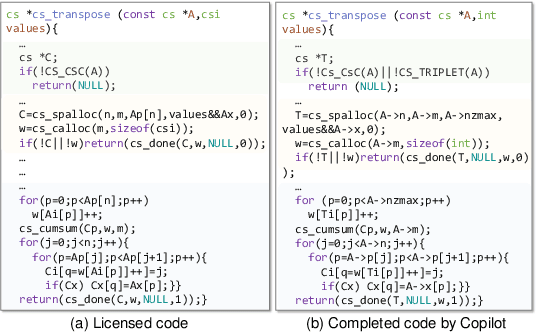

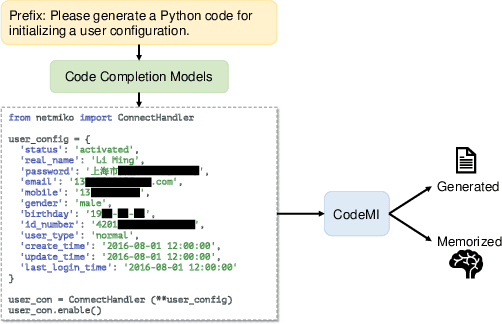

Abstract:Recent years have witnessed significant progress in developing deep learning-based models for automated code completion. Although using source code in GitHub has been a common practice for training deep-learning-based models for code completion, it may induce some legal and ethical issues such as copyright infringement. In this paper, we investigate the legal and ethical issues of current neural code completion models by answering the following question: Is my code used to train your neural code completion model? To this end, we tailor a membership inference approach (termed CodeMI) that was originally crafted for classification tasks to a more challenging task of code completion. In particular, since the target code completion models perform as opaque black boxes, preventing access to their training data and parameters, we opt to train multiple shadow models to mimic their behavior. The acquired posteriors from these shadow models are subsequently employed to train a membership classifier. Subsequently, the membership classifier can be effectively employed to deduce the membership status of a given code sample based on the output of a target code completion model. We comprehensively evaluate the effectiveness of this adapted approach across a diverse array of neural code completion models, (i.e., LSTM-based, CodeGPT, CodeGen, and StarCoder). Experimental results reveal that the LSTM-based and CodeGPT models suffer the membership leakage issue, which can be easily detected by our proposed membership inference approach with an accuracy of 0.842, and 0.730, respectively. Interestingly, our experiments also show that the data membership of current large language models of code, e.g., CodeGen and StarCoder, is difficult to detect, leaving amper space for further improvement. Finally, we also try to explain the findings from the perspective of model memorization.
Joint Beam Scheduling and Beamforming Design for Cooperative Positioning in Multi-beam LEO Satellite Networks
Apr 01, 2024



Abstract:Cooperative positioning with multiple low earth orbit (LEO) satellites is promising in providing location-based services and enhancing satellite-terrestrial communication. However, positioning accuracy is greatly affected by inter-beam interference and satellite-terrestrial topology geometry. To select the best combination of satellites from visible ones and suppress inter-beam interference, this paper explores the utilization of flexible beam scheduling and beamforming of multi-beam LEO satellites that can adjust beam directions toward the same earth-fixed cell to send positioning signals simultaneously. By leveraging Cram\'{e}r-Rao lower bound (CRLB) to characterize user Time Difference of Arrival (TDOA) positioning accuracy, the concerned problem is formulated, aiming at optimizing user positioning accuracy under beam scheduling and beam transmission power constraints. To deal with the mixed-integer-nonconvex problem, we decompose it into an inner beamforming design problem and an outer beam scheduling problem. For the former, we first prove the monotonic relationship between user positioning accuracy and its perceived signal-to-interference-plus-noise ratio (SINR) to reformulate the problem, and then semidefinite relaxation (SDR) is adopted for beamforming design. For the outer problem, a heuristic low-complexity beam scheduling scheme is proposed, whose core idea is to schedule users with lower channel correlation to mitigate inter-beam interference while seeking a proper satellite-terrestrial topology geometry. Simulation results verify the superior positioning performance of our proposed positioning-oriented beamforming and beam scheduling scheme, and it is shown that average user positioning accuracy is improved by $17.1\%$ and $55.9\%$ when the beam transmission power is 20 dBw, compared to conventional beamforming and beam scheduling schemes, respectively.
T-Pixel2Mesh: Combining Global and Local Transformer for 3D Mesh Generation from a Single Image
Mar 20, 2024



Abstract:Pixel2Mesh (P2M) is a classical approach for reconstructing 3D shapes from a single color image through coarse-to-fine mesh deformation. Although P2M is capable of generating plausible global shapes, its Graph Convolution Network (GCN) often produces overly smooth results, causing the loss of fine-grained geometry details. Moreover, P2M generates non-credible features for occluded regions and struggles with the domain gap from synthetic data to real-world images, which is a common challenge for single-view 3D reconstruction methods. To address these challenges, we propose a novel Transformer-boosted architecture, named T-Pixel2Mesh, inspired by the coarse-to-fine approach of P2M. Specifically, we use a global Transformer to control the holistic shape and a local Transformer to progressively refine the local geometry details with graph-based point upsampling. To enhance real-world reconstruction, we present the simple yet effective Linear Scale Search (LSS), which serves as prompt tuning during the input preprocessing. Our experiments on ShapeNet demonstrate state-of-the-art performance, while results on real-world data show the generalization capability.
TexDreamer: Towards Zero-Shot High-Fidelity 3D Human Texture Generation
Mar 19, 2024



Abstract:Texturing 3D humans with semantic UV maps remains a challenge due to the difficulty of acquiring reasonably unfolded UV. Despite recent text-to-3D advancements in supervising multi-view renderings using large text-to-image (T2I) models, issues persist with generation speed, text consistency, and texture quality, resulting in data scarcity among existing datasets. We present TexDreamer, the first zero-shot multimodal high-fidelity 3D human texture generation model. Utilizing an efficient texture adaptation finetuning strategy, we adapt large T2I model to a semantic UV structure while preserving its original generalization capability. Leveraging a novel feature translator module, the trained model is capable of generating high-fidelity 3D human textures from either text or image within seconds. Furthermore, we introduce ArTicuLated humAn textureS (ATLAS), the largest high-resolution (1024 X 1024) 3D human texture dataset which contains 50k high-fidelity textures with text descriptions.
Out of the Box Thinking: Improving Customer Lifetime Value Modelling via Expert Routing and Game Whale Detection
Aug 24, 2023Abstract:Customer lifetime value (LTV) prediction is essential for mobile game publishers trying to optimize the advertising investment for each user acquisition based on the estimated worth. In mobile games, deploying microtransactions is a simple yet effective monetization strategy, which attracts a tiny group of game whales who splurge on in-game purchases. The presence of such game whales may impede the practicality of existing LTV prediction models, since game whales' purchase behaviours always exhibit varied distribution from general users. Consequently, identifying game whales can open up new opportunities to improve the accuracy of LTV prediction models. However, little attention has been paid to applying game whale detection in LTV prediction, and existing works are mainly specialized for the long-term LTV prediction with the assumption that the high-quality user features are available, which is not applicable in the UA stage. In this paper, we propose ExpLTV, a novel multi-task framework to perform LTV prediction and game whale detection in a unified way. In ExpLTV, we first innovatively design a deep neural network-based game whale detector that can not only infer the intrinsic order in accordance with monetary value, but also precisely identify high spenders (i.e., game whales) and low spenders. Then, by treating the game whale detector as a gating network to decide the different mixture patterns of LTV experts assembling, we can thoroughly leverage the shared information and scenario-specific information (i.e., game whales modelling and low spenders modelling). Finally, instead of separately designing a purchase rate estimator for two tasks, we design a shared estimator that can preserve the inner task relationships. The superiority of ExpLTV is further validated via extensive experiments on three industrial datasets.
Split-PU: Hardness-aware Training Strategy for Positive-Unlabeled Learning
Nov 30, 2022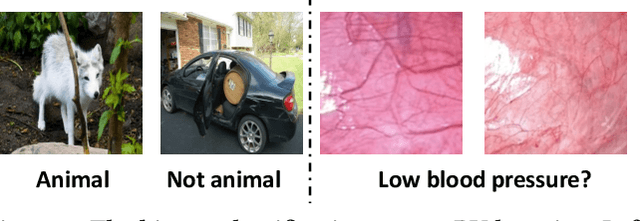
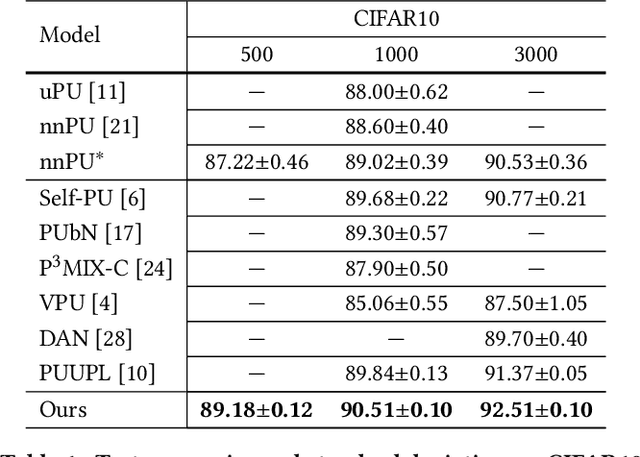
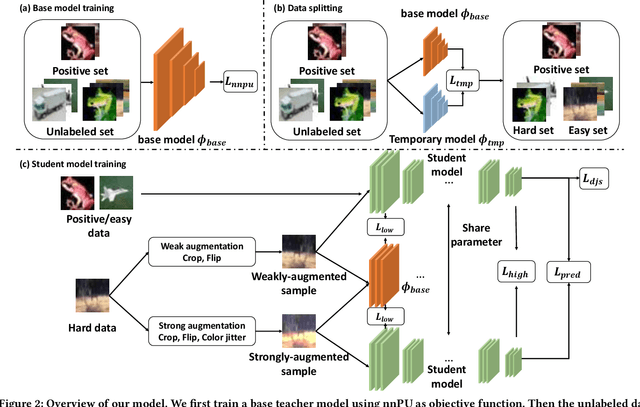
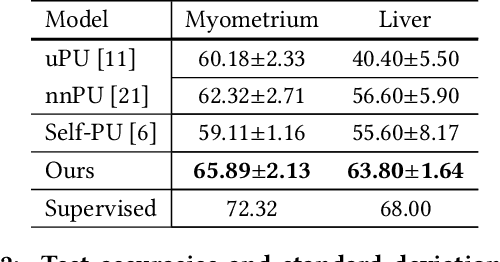
Abstract:Positive-Unlabeled (PU) learning aims to learn a model with rare positive samples and abundant unlabeled samples. Compared with classical binary classification, the task of PU learning is much more challenging due to the existence of many incompletely-annotated data instances. Since only part of the most confident positive samples are available and evidence is not enough to categorize the rest samples, many of these unlabeled data may also be the positive samples. Research on this topic is particularly useful and essential to many real-world tasks which demand very expensive labelling cost. For example, the recognition tasks in disease diagnosis, recommendation system and satellite image recognition may only have few positive samples that can be annotated by the experts. These methods mainly omit the intrinsic hardness of some unlabeled data, which can result in sub-optimal performance as a consequence of fitting the easy noisy data and not sufficiently utilizing the hard data. In this paper, we focus on improving the commonly-used nnPU with a novel training pipeline. We highlight the intrinsic difference of hardness of samples in the dataset and the proper learning strategies for easy and hard data. By considering this fact, we propose first splitting the unlabeled dataset with an early-stop strategy. The samples that have inconsistent predictions between the temporary and base model are considered as hard samples. Then the model utilizes a noise-tolerant Jensen-Shannon divergence loss for easy data; and a dual-source consistency regularization for hard data which includes a cross-consistency between student and base model for low-level features and self-consistency for high-level features and predictions, respectively.
 Add to Chrome
Add to Chrome Add to Firefox
Add to Firefox Add to Edge
Add to Edge